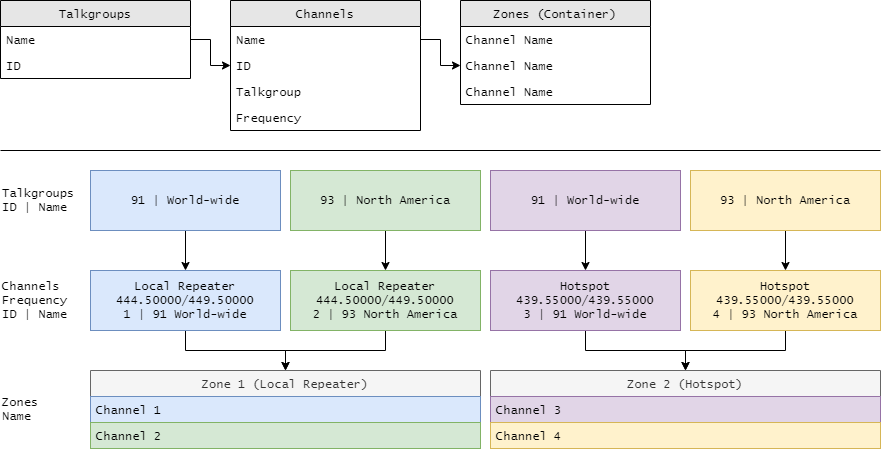If you are a new DMR user, you may find that the transition from analog to digital is a bit confusing. Especially when programming talkgroups, channels, and zones. Hopefully, this post will help clear some of this up.
In the analog world, we would simply program frequencies to a channel and that was the end of the story. There is a little more with DMR and you need to follow a bottom-up approach when programming your radio.
A DMR talkgroup is a method of grouping or assembling multiple users (Radio ID’s) to a single contact. An analogy I like to use is imagining the DMR network as a university campus. You can’t listen to all the lectures at once, so you go to an individual lecture hall or room (talkgroup.)
Channels contain the information required to connect to the repeater and select the talkgroup. Each channel is programmed with the Channel Name, Frequencies, and Talkgroup. There is a myriad of other settings, but for simplicity’s sake, this is the easiest way to “spin the knob” to get to a different talkgroup. Using the university analogy, channels are the method that you use to get to the individual lecture rooms. Whether you are driving, riding a bike, teleconferencing, or walking, you will get to the same room/lecture.
Zones are a way of organizing a collection of channels. You can organize zones however you would like. Think of them as file folders. Mostly, people organize the zones based on location. The following list is an example of zones that are set up by location:
- Zone 1 – Local DMR Repeater
- Zone 2 – Hotspot
- Zone 3 – Nearby DMR Repeater
- Zone 4 – Local Analog Repeaters
When you are creating your code-plug, remember to use a bottom-up approach:
Talkgroup -> Channel -> Zone
There are two diagrams below showing the basic relationships and flow:

Hopefully, this has cleared up some of the confusion. Feel free to post comments on how to improve this post.
Can someone email this to me so I can print it out? DM R is stumping me.
robert6495@me.com
Tks. Bob KA4SGR
Hi Bob. I sent you an email with the article as a PDF. 73!
Fantastic explanation and visuals. I’m having database modeling flashbacks. 🙂 Thanks! KI5IUW (hoping to be KE1THE soon, waiting on new vanity).
Glad to help! Well, I used to be a DBA at one point in my career hihi. Good luck on the new vanity!
A bit over simplified as it doesn’t mention contacts, receive groups, scan groups but still a good starting place.
Yes, this was intentional in an attempt to ease new users into the concept. I plan to write an additional post regarding the items you mentioned. Cheers & 73!
Chris, I talked to you tonight from Springfield and you gave me a tip on talkgroups and how to scan by using channels with TG assigned. Good stuff. Thanks for the info above. well presented and a great place to start. thanks for this website. Looking forward to exploring the rest
great website and intro to talkgroups. Thank you for doing this website
Glad it has helped, Matt. Feel free to contact me anytime if you have any questions. info@w0wc.com
Cheers & 73!
Three years later.
I’m a rookie operator and my son gave me an Alinco DJ-MD5 XLT for Christmas. Still trying to wrap my head around all the DMR terminology and connections back and forth, but this was one of the best basic explanations I’ve seen.
Thank you for the KISS approach on this topic. Very clear and easy to follow.
Great that you took the time to publish this easy to follow explanation.